| (insert your NIE or newspaper logo here) |
Weekly Online LessonOnline Lesson ArchiveGrade Level: 6-9
|
Urban Rivers
 A
vessel delivering oil to a refinery at Paulsboro, New Jersey, just across
the Delaware River from Philadelphia, Pennsylvania, began leaking on
Friday, November 26, 2004.
A
vessel delivering oil to a refinery at Paulsboro, New Jersey, just across
the Delaware River from Philadelphia, Pennsylvania, began leaking on
Friday, November 26, 2004.
Such oil spills can degrade water quality and harm the environment. Fortunately, the leak was reported to the Coast Guard, and the oil spill -- about 30,000 gallons --was contained by Saturday afternoon.
Protecting rivers, like the Delaware, which run through or near large urban areas, is important to the health of these cities and their residents. After all, these rivers provide a steady water supply, a transport route for goods, recreational opportunities, and wildlife habitats.
Many cities were established along these river routes early in the nation's history, since, without adequate roadways, they offered the easiest way to get people and supplies from one place to another over long distances.
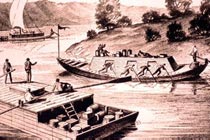 Many
rivers also provide a good water supply, which was essential in the
settling and development of the relatively arid American West.
Many
rivers also provide a good water supply, which was essential in the
settling and development of the relatively arid American West.
Rivers that flow through urban areas directly support the lives and livelihoods of thousands -- and sometimes millions -- of people. At the same time, river health is threatened by these large populations by their heavy pollution, erosion, recreation, and commercial use.
This week, you're going to think about how urban rivers have shaped the region in which you live. You'll start by learning about basic river geology and ecology, then you'll examine a case study -- life and living along the Delaware River.
River Basics
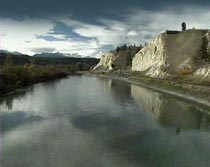 First,
let's visit the ThinkQuest Library and check out the entry, Rivers:
Veins of the Earth (Flash Player required). Click to enter,
then choose English.
First,
let's visit the ThinkQuest Library and check out the entry, Rivers:
Veins of the Earth (Flash Player required). Click to enter,
then choose English.
Click on the Introduction icon in the scrolling menu at the top. Read it, then click the icon for Lesson.
Review the Lesson Outline, then proceed using the arrow button in the navigate area.
In Drainage Patterns, click on the three different illustrations to view larger versions of each pattern type. Do you recognize which type or types that exist in your region?
Continue through the lesson to learn about the Hydrological Cycle and Hydrographs. How do these two relate to one another?
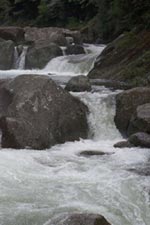 Next,
discover the Energy of a River. What roles do velocity
and volume play?
Next,
discover the Energy of a River. What roles do velocity
and volume play?
What are the different kinds of River Erosion and River Transportation? What conditions cause River Deposition?
Now look at the characteristics of the Course of the River, including the Upper, Middle, and Lower regions.
Consider a large river near your neighborhood -- can you identify the characteristics of each of these regions of the river? In what ways do people use the upper, middle, and lower portions?
Review the Uses of Rivers, including problems caused by use. Can you identify the ways in which your city uses a nearby river? Do any problems from use exist?
Case Study: The Delaware River
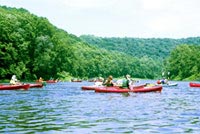 Let's
journey to the Pennsylvania-New Jersey border and start wading in the
Delaware River to discover what it provides urbanites in this region.
Let's
journey to the Pennsylvania-New Jersey border and start wading in the
Delaware River to discover what it provides urbanites in this region.
To begin, let's take join a photographic tour of water use in Philadelphia by visiting Watersheds.tv's Special Features page and exploring Urban Watersheds.
Make sure you have your speakers turned on and Shockwave Player installed, then click Start this multimedia presentation now. After each part plays, the next part will download and play automatically.
(NOTE: After the first part downloads, you may get an error message saying that your system requires an "Xtra." Click OK once or twice, and you'll be able to proceed to the presentation. This error may occur at the start of subsequent sections.)
Do you see similar uses of water in your home town? Does your water come from a river, groundwater, or a combination of both?
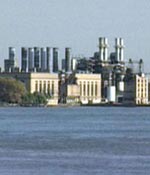 Now
let's travel to the GreenTreks feature, On
Location: Delaware River.
Now
let's travel to the GreenTreks feature, On
Location: Delaware River.
Begin your trek with reading briefly About the river, and reviewing the Map. Then, read about the Documentary and watch the Sneak Preview (audio speakers and RealPlayer required).
Refer to a map of the region and look for big cities, as well as smaller communities, within the Delaware Basin. Who lives near the headwaters of the river? Who lives downstream? Why is a healthy river important to the health of area residents?
To gain further insight into how the Delaware River affects life and living here, browse through the Journal of Sights and Sounds.
 Watch
some of the Videos included here, such as Banking
In On Streambanks, Delaware
River Water Gap, Our
Watersheds, Scenic
Towns on the Upper Delaware, and Touch
the Water.
Watch
some of the Videos included here, such as Banking
In On Streambanks, Delaware
River Water Gap, Our
Watersheds, Scenic
Towns on the Upper Delaware, and Touch
the Water.
What types of activities have degraded the watershed over the years? In what ways are citizens, local governments, and organizations helping to restore or protect areas of the river? What do you think makes people care about the river? Why is protecting the non-urban stretches of the river as important as protecting the urban stretches?
What kinds of activities do you enjoy on or near the river? If you have visited more than one river, what differences and similarities between the rivers -- the way they flow, the geology, ecology, types of recreation, industrial uses, etc. -- did you notice?
Also check out the Multimedia packages listed below the Videos. These include a 360 look at the issue of dredging the Delaware River, plus you can Meet the Delaware Riverkeeper and Meet the Eel Man.
Do one or more rivers in your region have Riverkeepers or other groups that work to restore or protect them? In what ways do local government agencies manage recreational or commercial uses of the river?
If you have time, browse the Journal Articles and Topics for additional viewpoints of the Delaware River.
Newspaper Activities
In issues of Targetnewspaper find news stories or features about rivers or river use in your region. Does the article explain the river's importance to your community's residents? Does the story highlight a meeting or development that affects how the river is used? If the article is about protecting or restoring one or more stretches of the river, what exactly is being done, who is doing it, and why? In what ways do activities in an urban stretch of the river affect communities downstream? Can you find articles about new recreational opportunities on the river in urban areas or away from cities in more rural stretches of the watershed? If any articles include a map, does it illustrate the entire river or watershed or just a portion of it?
© Copyright 2004
Learners
Online,
Inc.
